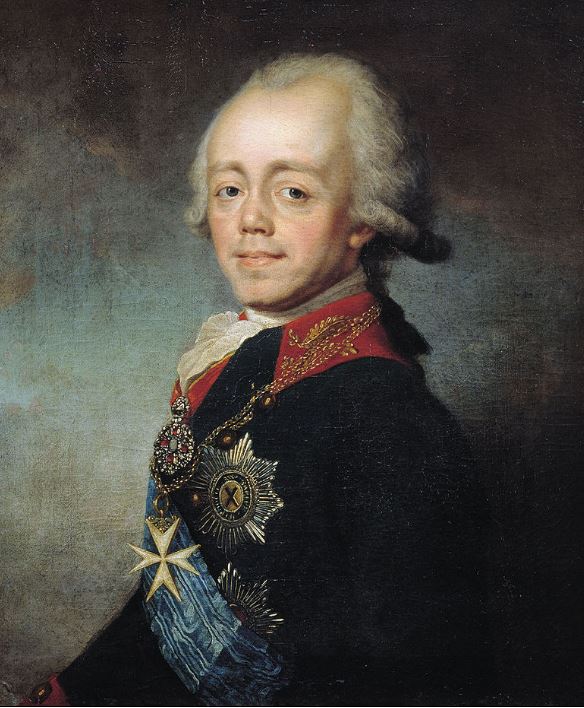Painting the Face of a Dead Emperor

Painting the Face of a Dead Emperor Tsar Paul I, Stepan Shchukin. The dead Emperor whose face was painted by Marie Antoinette’s hairdresser.
Yesterday was the anniversary of the death of Tsar Paul I. Normally I pay little attention to Russian history except for the costumes, ghosts, and Faberge objets, but blundered across this happy, if macabre, memory from the memoirs of Léonard-Alexis Autié, Marie Antoinette’s coiffeur, who perhaps started the tradition of calling celebrity hairdressers by their first names. Léonard is a shocking name-dropper, but in this case seems to have been in the right place at the opportune time.
Paul I. died suddenly, as everyone knows, in the month of March, 1801. Many conjectures have been hazarded as to the cause of this unexpected death; and in the interest of my publisher, if I ever have one, I shall not repeat one of them. Certain books are treated, on their arrival in Russia, with as scant courtesy as that extended to the milliners’ husbands; and I should be in despair if mine, presuming that book there will be, should be placed on the index of the director of police, a functionary of whom I beg to declare myself the very humble servant.
I will content myself, therefore, with saying that the late Paul I. was an emperor endowed with more than the ordinary allowance of personal hideousness, and that he did not recover, after his death, a nobility of feature with which he had not been favoured in life. Nevertheless, it was necessary that, according to custom, he should be exhibited before the eyes of the people; and means were sought to diminish as much as possible the effect of the rapid and revolting decomposition of His defunct Majesty’s features. I was sent for to the Palace to advise upon this expedient. When I stood in presence of the corpse, I realized that the alteration in the face was due rather to the actual colour of the skin than to any displacement of the muscles, and I thought that with the aid of a little white and rouge, cunningly applied, I could succeed in giving a more life-like colour to this dead flesh. I next brushed up and curled the Emperor’s hair; and in the end I succeeded in restoring this face, in which decomposition had already begun its hideous work, so well, that Paul I. was actually less ugly on his state bed of death than he had been while living.
I had just reached my fifty-fifth year when I thus set the last touch to the edifice of my reputation. I had followed the career of a hair-dresser in all its ramifications; I had distinguished myself in the invention of every style of head-dress; no shade, no texture of hair had escaped the exercise of my art; but one thing was wanting to achieve my glory: the exploit of dressing the hair and painting the face of a corpse. This last complementary feat I achieved on the 24th of March, 1801.
Souvenirs of Léonard: Hairdresser to Queen Marie-Antoinette, Volume 2, Léonard, 1896
Tsar Paul I was strangled by some of his nobles on 23 March 1801, a fact that Léonard gavotted around with admirable tact and one eye on the censor. The note about milliners’ husbands was a reference to a flood of pretty milliners coming to Russia from Paris and becoming mistresses to the aristocracy. If, by chance, a milliner’s devoted husband followed her, he was unceremoniously bundled back to France so as not to spoil the fun. Léonard was, in fact, in Russia at the time of the Tsar’s murder, having fled the French Revolution, not wishing to lose his head for dressing a royal head. That said, there is considerable doubt about the many titillating tit-bits in Léonard’s volume, which was published posthumously in 1838. Léonard died in 1820 and it has been suggested that fantasist Étienne-Léon de Lamothe-Langon, whom we have met in these pages before, was the real author.
Léonard’s (if it is his) reference to face-painting seems to suggest that it was so commonplace at this date (1801) as to be on his bucket list. There is a longish passage in The Victorian Book of the Dead from an 1884 paper about a barber who painted the faces of the dead, but I have found surprisingly little about the practice in the nineteenth-century press, which was otherwise always avid for a morbid sensation. It seems to have been practiced primarily in cases of discoloration or decomposition and was not necessarily routine until the twentieth century. We find instructions for painting, rouging, or otherwise making up the corpse emphasized only in post-1900 embalming texts—and even then there was a certain revulsion by social critics against overdoing it. The American Way of Death, by Jessica Mitford and, of course, The Loved One, by Evelyn Waugh had some sharpish comments about cosmetic treatments for the dead.
Of course, there are different standards for royalty, especially murdered royalty who need to look their best for lying in state. And, really, nothing in the preservation/restoration line is too good for the sovereign ruler of all Russia. Just ask Lenin. He, too, is said to look better than the day he died.
Other examples of corpse face-painting from nineteenth-century sources? chriswoodyard8 AT gmail.com
Chris Woodyard is the author of The Victorian Book of the Dead, The Ghost Wore Black, The Headless Horror, The Face in the Window, and the 7-volume Haunted Ohio series. She is also the chronicler of the adventures of that amiable murderess Mrs Daffodil in A Spot of Bother: Four Macabre Tales. The books are available in paperback and for Kindle. Indexes and fact sheets for all of these books may be found by searching hauntedohiobooks.com. Join her on FB at Haunted Ohio by Chris Woodyard or The Victorian Book of the Dead.
